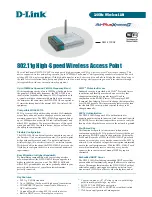
WIRELESS ROUTER ADSL
55
APPENDIX A
Wireless LAN Overview
This section introduces the wireless LAN and some basic configurations. Wireless LANs can be as
simple as two computers with wireless LAN cards communicating in a peer-to-peer network or as
complex as a number of computers with wireless LAN cards communicating through access points
which bridge network traffic to the wired LAN.
Channel
The range of radio frequencies used by IEEE 802.11b wireless devices is called a “channel”. Channels
available depend on your geographical area. You may have a choice of channels (for your region) so
you should use a different channel than an adjacent AP (access point) to reduce interference.
Interference occurs when radio signals from different access points overlap causing interference and
degrading performance.
Adjacent channels partially overlap however. To avoid interference due to overlap, your AP should be
on a channel at least five channels away from a channel that an adjacent AP is using. For example, if
your region has 11 channels and an adjacent AP is using channel 1, then you need to select a channel
between 6 or 11.
ESS ID
An Extended Service Set (ESS) is a group of access points or wireless gateways connected to a wired
LAN on the same subnet. An ESS ID uniquely identifies each set. All access points or wireless
gateways and their associated wireless stations in the same set must have the same ESSID.
RTS/CTS
A hidden node occurs when two stations are within range of the same access point, but are not within
range of each other. The following figure illustrates a hidden node. Both stations (STA) are within
range of the access point (AP) or wireless gateway, but out-of-range of each other, so they cannot
“hear” each other, that is they do not know if the channel is currently being used. Therefore, they are
considered hidden from each other.
When station A sends data to the ADSL Router, it might not know that the station B is already using
the channel. If these two stations send data at the same time, collisions may occur when both sets of
data arrive at the AP at the same time, resulting in a loss of messages for both stations.
RTS/CTS is designed to prevent collisions due to hidden nodes. An RTS/CTS defines the biggest size
data frame you can send before an RTS (Request To Send)/CTS (Clear to Send) handshake is invoked.
When a data frame exceeds the RTS/CTS value you set (between 0 to 2432 bytes), the station that
wants to transmit this frame must first send an RTS (Request To Send) message to the AP for
Содержание A02-RA210-W54
Страница 1: ...WIRELESS ROUTER ADSL A02 RA240 W54 A02 RA210 W54 USER S MANUAL A02 RA24 1 0 W54_ME01...
Страница 2: ......
Страница 6: ......
Страница 10: ...WIRELESS ROUTER ADSL 4 1 4 Wireless Router ADSL Application...
Страница 48: ...WIRELESS ROUTER ADSL 42 Remote LAN A02 RA3 Office LAN A02 RA240 W54...







































